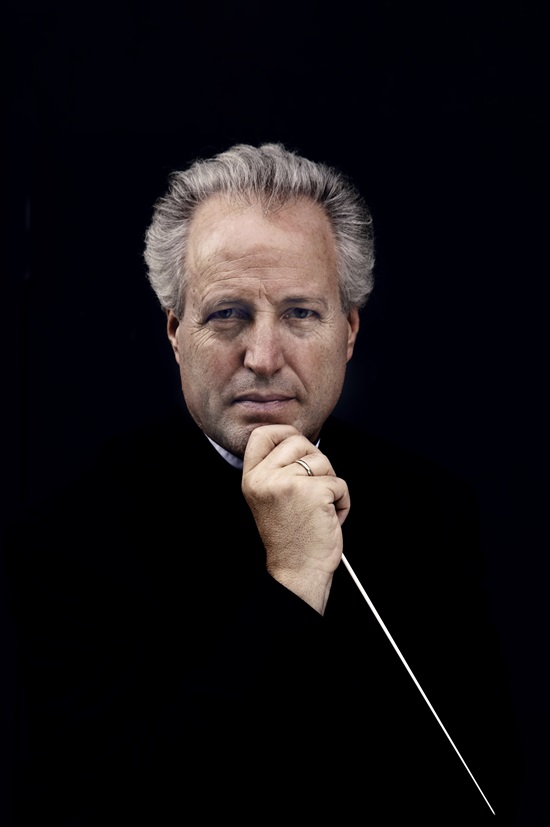Honeck brings fervent Bruckner and limpid Beethoven to latest NSO stand

Conductor Manfred Honeck. Photo: Felix Broede
Ever since Manfred Honeck last conducted the National Symphony Orchestra, in 2020, hopes for his return to the podium have been high. The Austrian conductor, in his sixteenth season as music director of the PIttsburgh Symphony Orchestra, has had his contract there extended through the 2027-2028 season. The NSO musicians sounded quite happy to welcome him back Thursday night for an evening of Beethoven and Bruckner in the Kennedy Center Concert Hall.
The Overture to Fidelio, the last one Beethoven composed (Op. 72b) for this opera, opened the concert with a burst of energy. Honeck’s direction brought out spirited contrasts: loud tutti fanfares answered calmly by woodwinds and horns. The increasingly fast tempi imposed by the conductor put the ensemble on the back foot in terms of unified attacks, especially in the precipitously paced coda.
The two Romances for Violin and Orchestra offered a soothing antidote, not least because of the elegant solo playing of NSO concertmaster Nurit Bar-Josef. She started with Romance No. 2, which revealed the prominent vibrato in her tone, giving the melodic line an individualistic edge. Honeck accompanied with masterful control, guiding the orchestra faultlessly to keep pace with the soloist, in an ensemble sound beautifully calibrated to support her.
Romance No. 1 proved the highlight of the first half, with the double-stop writing playing to Bar-Josef’s strengths: the twin polyphonic lines of the part, connected with striking legato and less vibrato, stood out with impeccable clarity. More compact in terms of length and with a more intimate instrumentation, the piece shimmered with impressive serenity from the NSO.
The centerpiece of the evening, however, was a magisterial performance of Anton Bruckner’s Ninth Symphony. Honeck’s highly praised recording of this piece, released with the Pittsburgh Symphony Orchestra in 2019, added to the anticipation. Honeck’s live interpretation lasted a little over an hour, like the recording, and in it one heard the intense expression of Honeck’s Catholic faith, no less sincerely lived than Bruckner’s.
Honeck’s lengthy booklet essay, released with the recording, lays out in great detail the spiritual dimensions of this symphony, which Bruckner dedicated “to the beloved God.” Out of the mysterious opening section, a majestic horn theme arose. With precise gestures Honeck marshaled the force of the NSO brass through many overwhelming crescendos of sound. Lush strings warmed the ardent second theme, while at other times a tense quiet prevailed.
The overall pacing of the work was perhaps too hasty. Not all Bruckner needs to be stretched out to the tempi favored by Sergiu Celibidache, but even the Scherzo could have used a little more breathing room. Honeck turned to forceful gestures, like stabs or karate chops, to mark the rather severe accents he wanted in what he has termed “an infernal dance cutting straight to the bone.” The shadowy Trio section, much faster and lighter, whirled mischievously.
At the time of his death in 1896, Bruckner had managed to complete only the first three movements of this planned four-movement work. Rather than attempt to complete the symphony with a reconstruction, Honeck lets the score stand on its own, which puts all of the emphasis on the glorious ascension to heaven that is the slow movement. The composer called the third movement his “Farewell to Life,” in which Honeck hears echoes of sacred music, especially the sinner’s plea for mercy in the “Agnus Dei.”
The violin section obliged with a gorgeously warm tone in the opening of this movement, which blossomed into the full orchestral sound. The trumpet arose on a hopeful theme, reminiscent of Wagner’s Parsifal, answered by cushioned sounds from oboe and horn. Honeck took his time with the appearance of a repeated trumpet fanfare theme, an idea that shivered with ecstasy both times it was heard.
Adding to the otherwise magnificent sounds called for from the vast horn section, in the third movement Bruckner has four of the horn players switch over to Wagner tubas, another homage to the composer Bruckner called “the master.” These passages glowed with a golden melancholy, while the violins surged powerfully on the low-set melody that followed.
The piece reached its climax on a fortissimo chord bristling with dissonance, which rang out into a long-held rest. Treble textures sang in response, with the lower instruments falling silent for a time. The violins floated angelic tremolos as the piece settled into its serene conclusion in E major, after having glimpsed the realms beyond. It was a fine start to the Bruckner year, marking the 200th anniversary of his birth this September, to be followed by Marek Janowski returning to the NSO this fall with the composer’s Fourth Symphony.
The program will be repeated 11:30 a.m. Friday and 8 p.m. Saturday. kennedy-center.org
